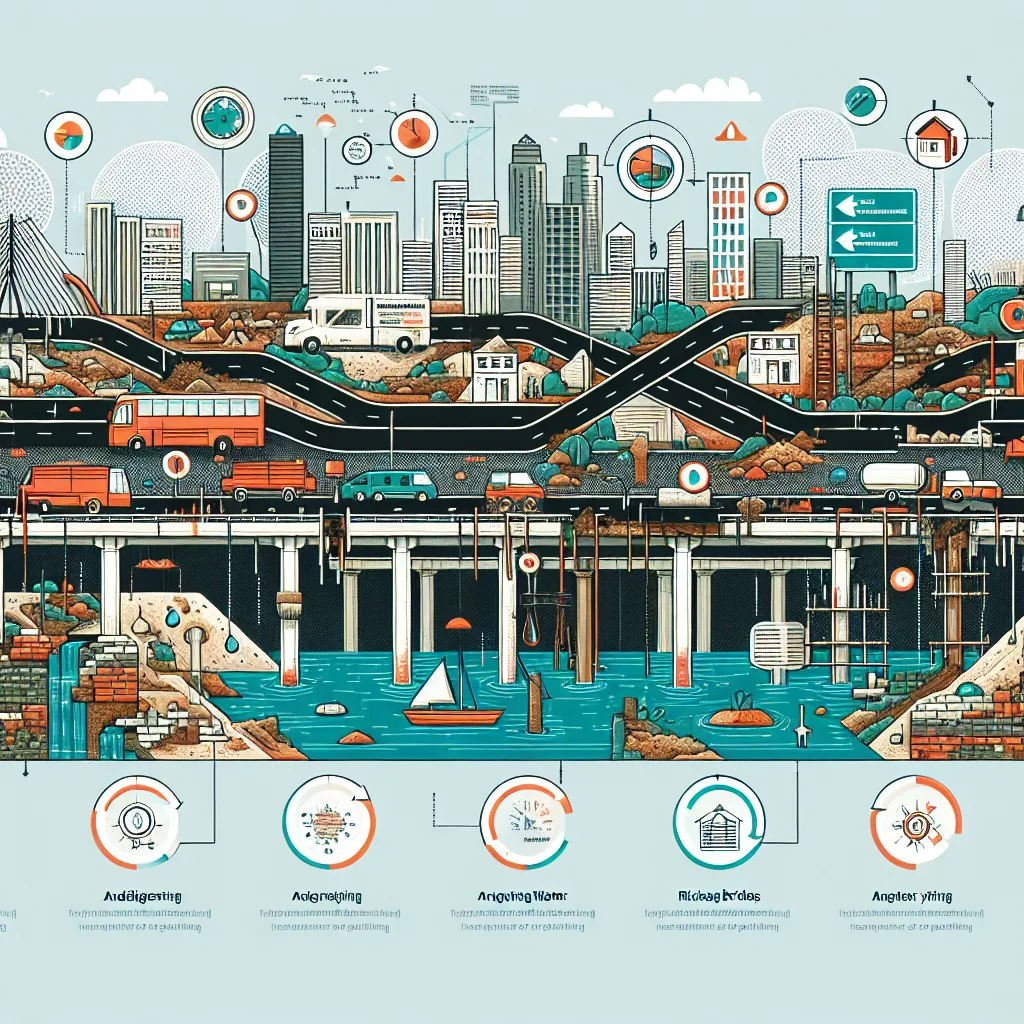As an experienced IELTS instructor, I’ve noticed that topics related to urban development and infrastructure are increasingly common in IELTS Writing Task 2. One such topic that has gained prominence is “how to address the challenges of aging infrastructure.” This issue is particularly relevant as many cities worldwide grapple with deteriorating buildings, roads, and public utilities. Let’s explore this topic through sample essays and in-depth analysis to help you excel in your IELTS Writing Task 2.
 Aging Infrastructure Challenges
Aging Infrastructure Challenges
Analyzing the Task Question
Let’s begin by examining a potential IELTS Writing Task 2 question on this topic:
Many cities around the world are facing problems with aging infrastructure such as roads, bridges, and public transport systems. What are the main challenges this presents, and how can governments effectively address these issues?
This question is a typical problem-solution essay that requires you to:
- Identify the main challenges presented by aging infrastructure
- Propose effective solutions that governments can implement
Let’s now look at sample essays for different band scores, analyzing why they achieve their respective scores.
Sample Essay for Band 8-9
High Band Score Essay
As urban centers across the globe continue to expand and evolve, the issue of aging infrastructure has become increasingly prevalent, posing significant challenges for city planners and governments alike. The main difficulties arising from outdated infrastructure include safety concerns, reduced efficiency, and escalating maintenance costs. However, with strategic planning and investment, governments can effectively tackle these issues and revitalize their urban landscapes.
The foremost challenge presented by aging infrastructure is the potential risk to public safety. Deteriorating bridges, roads, and buildings can lead to catastrophic failures, endangering lives and causing widespread disruption. Moreover, outdated public transport systems often struggle to meet modern safety standards, increasing the likelihood of accidents. Another critical issue is the reduced efficiency of aging systems, which can hamper economic growth and quality of life. For instance, obsolete water and sewage systems may lead to frequent breakdowns and service interruptions, while congested roads and inadequate public transportation networks contribute to traffic jams and longer commute times.
To address these challenges effectively, governments must adopt a multi-faceted approach. Firstly, implementing comprehensive infrastructure assessment programs is crucial. This involves regular inspections and the use of advanced technologies like sensors and drones to identify potential hazards before they escalate. Secondly, prioritizing renovation and replacement projects based on critical needs and available resources is essential. This may involve difficult decisions, but focusing on the most urgent cases ensures optimal use of limited funds.
Furthermore, governments should explore innovative financing models to fund large-scale infrastructure projects. Public-private partnerships, for example, can leverage private sector expertise and capital while maintaining public oversight. Additionally, the implementation of smart city technologies can enhance the efficiency and longevity of infrastructure. IoT sensors, AI-driven maintenance schedules, and advanced materials can significantly extend the lifespan of both new and renovated structures.
In conclusion, while aging infrastructure presents formidable challenges, proactive and innovative approaches can effectively address these issues. By prioritizing safety, embracing technology, and seeking creative funding solutions, governments can not only overcome the problems posed by outdated systems but also lay the groundwork for more resilient and sustainable urban environments.
(Word count: 329)
Analysis of Band 8-9 Essay
This essay achieves a high band score for several reasons:
-
Task Response: The essay fully addresses all parts of the task, discussing both the challenges and solutions in detail.
-
Coherence and Cohesion: The essay is well-organized with clear paragraphing. It uses a variety of cohesive devices effectively (e.g., “Moreover,” “Furthermore,” “For instance”).
-
Lexical Resource: The essay demonstrates a wide range of vocabulary used accurately and appropriately (e.g., “prevalent,” “catastrophic failures,” “multi-faceted approach”).
-
Grammatical Range and Accuracy: The essay uses a variety of complex structures accurately (e.g., “While aging infrastructure presents formidable challenges, proactive and innovative approaches can effectively address these issues.”).
Sample Essay for Band 6-7
Medium Band Score Essay
Many cities around the world are facing problems with old infrastructure like roads, bridges, and public transport. This is causing big challenges for governments. In this essay, I will discuss the main problems and some ways to solve them.
One of the biggest challenges of aging infrastructure is safety. Old bridges and buildings can be dangerous and might collapse. This can hurt people and cause a lot of damage. Another problem is that old infrastructure is not efficient. For example, old roads can cause traffic jams, and old public transport can be slow and uncomfortable. This makes life harder for people in the city.
To solve these problems, governments need to take action. First, they should check all the old infrastructure regularly to find problems early. This can help prevent accidents. Second, governments should make plans to fix or replace the most important infrastructure first. This might be expensive, but it is necessary for safety and efficiency.
Governments can also try to find new ways to pay for fixing infrastructure. They could work with private companies to share the cost. Also, using new technology can help make infrastructure last longer and work better. For example, using strong materials for building roads can make them last longer.
In conclusion, aging infrastructure is a big problem for many cities, but there are ways to solve it. Governments need to focus on safety, plan carefully, and use new ideas to improve their infrastructure. This will help make cities better places to live.
(Word count: 253)
Analysis of Band 6-7 Essay
This essay achieves a medium band score for the following reasons:
-
Task Response: The essay addresses the main parts of the task, but the ideas are less fully developed compared to the Band 8-9 essay.
-
Coherence and Cohesion: The essay has a clear structure, but the use of cohesive devices is less sophisticated (e.g., frequent use of “Also” and “This”).
-
Lexical Resource: The vocabulary is adequate but less varied. Some attempts at more advanced vocabulary are present (e.g., “collapse,” “efficient”), but overall, the language is simpler.
-
Grammatical Range and Accuracy: The essay uses a mix of simple and complex sentences, but with less variety than the higher band essay. There are no significant errors, but the structures are generally less complex.
Key Vocabulary to Remember
- Infrastructure (noun) /ˌɪnfrəˈstrʌktʃər/ – the basic physical and organizational structures and facilities needed for the operation of a society or enterprise
- Deteriorating (adjective) /dɪˈtɪəriəreɪtɪŋ/ – becoming progressively worse
- Revitalize (verb) /ˌriːˈvaɪtəlaɪz/ – to give new life or vigor to
- Obsolete (adjective) /ˈɒbsəliːt/ – no longer produced or used; out of date
- Innovative (adjective) /ˈɪnəveɪtɪv/ – featuring new methods; advanced and original
- Resilient (adjective) /rɪˈzɪliənt/ – able to withstand or recover quickly from difficult conditions
- Prioritize (verb) /praɪˈɒrɪtaɪz/ – to designate or treat something as more important than other things
- Sustainable (adjective) /səˈsteɪnəbl/ – able to be maintained at a certain rate or level
Conclusion
Addressing the challenges of aging infrastructure is a complex topic that requires a comprehensive understanding of urban development, economics, and technology. As you prepare for your IELTS Writing Task 2, consider practicing with similar topics such as urban planning, sustainable development, and public transportation systems.
To further improve your skills, try writing your own essay on this topic and share it in the comments section below. This active practice will help you internalize the structure and vocabulary needed for high-scoring IELTS essays. Remember, consistent practice and feedback are key to achieving your desired band score in IELTS Writing Task 2.


